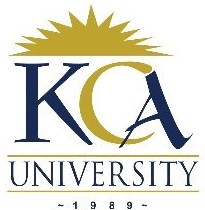
UNIVERSITY EXAMINATIONS: 2016/2017
EXAMINATION FOR THE DEGREE OF BACHELOR OF SCIENCE IN
INFORMATION TECHNOLOGY/BACHELOR OF SCIENCE IN
INFORMATION AND COMMUNICATIONS TECHNOLOGY
BIT 4302/BCT 3201: TELECOMMUNICATIONS
FULL TIME/PART TIME/DISTANCE LEARNING
DATE: DECEMBER, 2017 TIME: 2 HOURS
INSTRUCTIONS: Answer Question One & ANY OTHER TWO questions.
QUESTION ONE [30 MARKS]
a) With the aid of a relevant diagram, describe in detail the GSM Architecture
9Marks
b) With the aid of relevant diagrams, describe the principal components of a digital
communication system. 9 Marks
c) (i) Given a channel with an intended capacity of 12Mbps. The bandwidth of the
channel is 6 MHz. What signal-to-noise ratio is required in order to achieve this capacity?
4Marks
(ii) Explain why a transmission system cannot have infinite capacity for data
transmission 2 Marks
d) Discuss briefly the following:
(i) Fixed network delay 3 Marks
(ii) Variable network delay 3 Marks
QUESTION TWO [20 MARKS]
a) Explain briefly the four major constraints that face converged enterprise networks.
4 Marks
b. State the four components of a telephone system. 4 Marks
c) Briefly describe the following types of noise in data communications:
(i) Thermal noise 2 Marks
(ii) Inter-modulation Noise 2 Marks
d) Computer network designers must often rely on the existing telecommunications
facilities; this implies that the telephone systems is tightly intertwined with wide area
networks (WANs).
(i) Using a diagram, show the basic structure of the Public Switched Telephone
Network (PSTN) and identify the most bandwidth-constrained portion of the network.
5Marks
(ii)
Telecommunications systems use transmission media of various types. Explain
why, with any communications medium, the received signal will differ from the
transmitted
signal. 3
Marks
QUESTION THREE [20 MARKS]
a) Discuss the importance of segmenting messages before transmission. 5 Marks
b) (i) Discuss briefly the how RFID (Radio Frequency Identification) operates.
4Marks
(ii) What are tags/transponders in RFID system and how are they differentiated and
named? 6 Mark
c) Explain briefly the following key data communication concepts
(i) Session 1 Mark
(ii) Path 1 Mark
(iii) Circuit 1 Mark
(iv) Packetizing 1 Mark
(v) Routing 1 Mark
QUESTION FOUR [20 MARKS]
a) Information can be either analog (e.g., sound) or digital (e.g., computer data). Over the
years, telecommunications systems have evolved from analog to digital.
(i) Briefly explain the essential steps necessary for an analog signal to be converted
to digital signal. 6
Marks
(ii) By making suitable assumptions, determine the capacity in kbps necessary to
carry 80 kHz tone. 4 Marks
b) Discuss the importance of telecommunications and computer networks in today’s
business. 6 Marks
c. State the following basic features of GSM:
(i) Access method 1 Mark
(ii) BS transmission band 1 Mark
(iii) MU transmission band 1 Mark
(iv) Channel bandwidth 1 Mark
QUESTION FIVE [20 MARKS]
a) List and briefly describe the trade-offs that one needs to make before encoding data.
6 Marks
b) One primary difference between a WAN and a LAN is that a company or organization
must subscribe to an outside WAN service provider to use WAN carrier network services. A
WAN uses data links provided by carrier services to access the Internet and connect the locations
of an organization to each other, to locations of other organizations, to external services, and to
remote users. The WAN access Physical layer describes the physical connection between the
company network and the service provider network. Describe the following physical WAN
connections:
(i) Customer Premises Equipment (CPE) 2 Marks
(ii) Data Communications Equipment (DCE) 2 Marks
(iii) Demarcation Point 2 Marks
(iv) Local Loop 2 Marks
c) Identify the distinguishing features of the First Generation, Second Generation and Third
Generation Mobile Phone systems. 6 Marks
